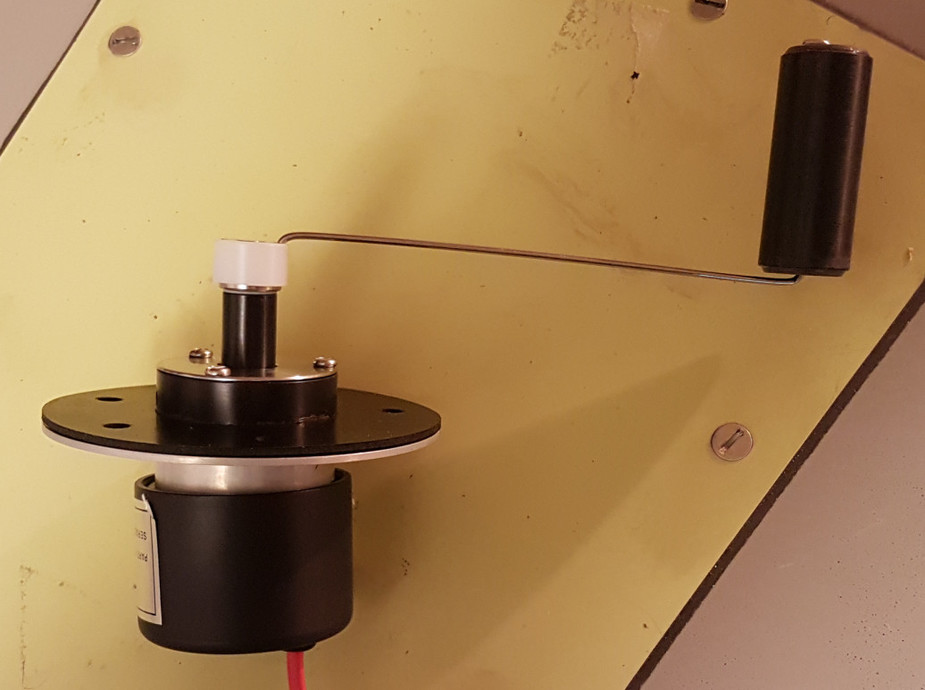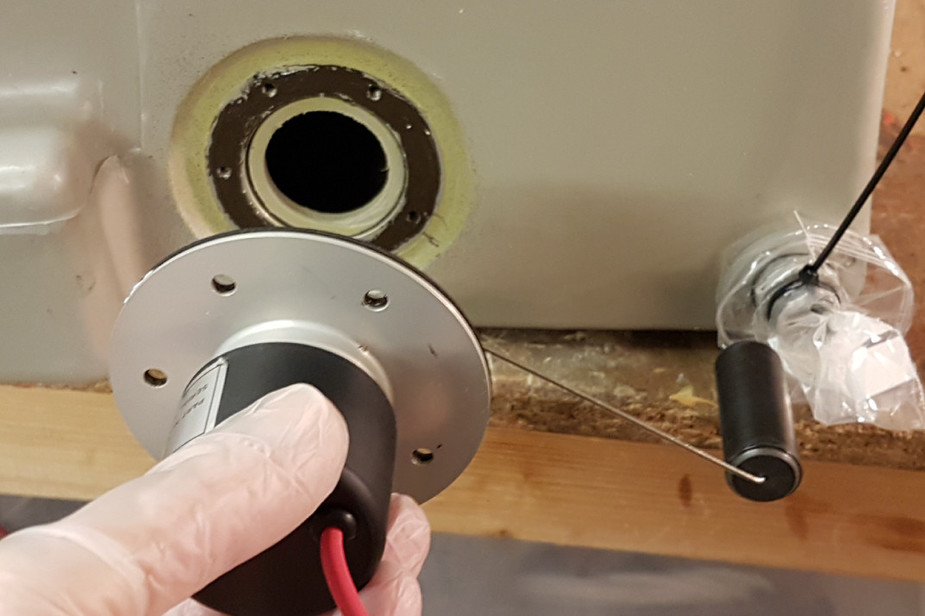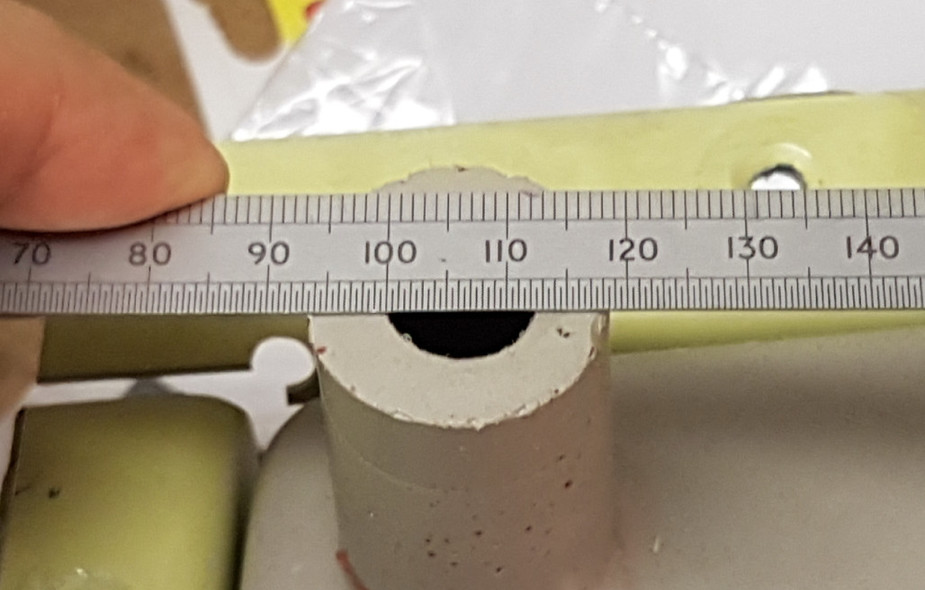These are the parts for the ice protected TKS tank vent. The “plastic bit” actually comes with the full TKS kit; you get two of them, to protect the fuel tank vents, but my plane already had them fitted when new (some ex Air Touring or even ex Socata “special”) so they didn’t get used. They are made from thin fibreglass

At time of writing, CAV say they don’t know anything about this issue, even though a mod like this was apparently issued by them some 10 years ago. Without it, the fluid spillage into the rear hull cavity is substantial (of the order of 10cc which is a lot of fluid) and happens on every takeoff, and happens even with the tank only 2/3 full. No wonder CAV had to include in the kit a new mounting bracket for the KG102A DG which relocates it slightly, to help protect it from fluid spillages during refilling (I think that bracket does nothing). Except that the spillages don’t necessarily occur during refilling (well, they can) but instead occur on every takeoff… I proved that by stuffing some paper tissues around the vent hole and they always come out soaked.
As detailed further back, the whole refilling arrangement is unsatisfactory, because it is hard to fully fill the tank without overfilling it and spilling the stuff everywhere. It really needs a capacitive sensor installed in the pipe leading to the tank so when that part fills up you can cut off the flow (assuming you are using some sort of pump).
Today we changed the TKS fluid level gauge. The original tank assembly was likely secondhand and the gauge installed in it had something wrong with it. It was reading about 0.5USG when the tank was empty. There was a possible mod comprising of just one resistor but I prefer to do it properly; also the reading was rather intermittent. After some months I managed to get a replacement gauge sent.


I found that the readout shows 0.0 when the float is 32mm above its lower travel stop. When the gauge is mounted in the tank as shown, the float pretty well exactly touches the bottom of the tank, so it reads 0.0 with about 32mm of fluid in there, but the outlet hole is some 20mm above the bottom, and the tank is tapered, so this is OK. For anything lower it just shows 0.0 (no negative readings).
This is why when you are filling the TKS tank, it is really easy to get an air lock and have a load of the sticky stuff shooting back up in your face. The hole is too small to let the air out during filling. I have solved it with a battery powered pump which pumps it slowly (pic posted further back)

OTOH, the hose which runs down to this point is about 25mm diameter.
Peter very interesting. Never needed it to be that exact. I just fill up before I depart knowing I have 1.5 hours of De-ice and 2.5 hrs anti-ice in the tank.
Can you go over the seal you made from the trailing edge of the TKS panel onto the wing? Im having some work done as I write this and am interested in your solution. You can PM me or Email or if you want just answer on this thread. Thanks.
It was just done with the recommended sealant, and carefully shaped. Normally one sticks masking tape (I used sellotape because it has a sharper edge) about 8mm away from the training edge, and of course on the training edge itself, and you need to do this accurately else it will look horrible when finished. Then I used a silicone rubber tool used by decorators to do curved fills to shape the sealant into a straight edge. That process needs to be done with extra care because if you press too hard you produce a concave fillet which, I assume, creates extra drag.
I may have some photos at home; currently I am on holiday.
This is also relevant.
So frustrating after writing a lengthy post to have it disappear.
Sorry to bother you on vacation. But its in the shop now and they are working on it as I write this.
Background:
I have had the panel since 1995. At first it was not sealed and water got under the panel. After a few years of exposure a few spots of filiform developed. I had them cleaned up repainted and a seal strip put in place. Fast forward a few years (7) and again Im seeing a few areas of corrosion extending out from underneath the TKS panel and under sealant strip. Last time around I dont think any corrosion inhibitor was used.
The seal we put on it seems did not adhere to the Titanium and a microscopic crack between the TKS panel and the seal allowed water seep in under the panel.
This time we plan on:
1 using scotchbrite to clean the corrosion away by lifiing the panel enough to do the job and blow out the residue.
2 Alodyne the bare aluminum
3 paint the exposed surface which is past the titanium edge of the TKS panel
4 Use Corrosion X once the paint harden so that the paint adheres
5 let the CX seep out from under the panel.
6 clean the area of CX and apply sealant to test. If it adheres properly than do the trailing edge.
Reading through the posts is it true you eventually used Chemseal 3204? Is CS3204 the same as PR1422?
Did you eventually use the clear Lacquer or is it polyurethane coating and brushed it onto/over the seal? If you did, then did you brush it on 5mm either side of the seal (Onto the titanium panel)? Did you use CA 8000/B900B urethane?
Sorry @C210_Flyer I have only just come across this.
Corrosion behind TKS panels, on aluminium skinned aircraft, is a major issue with these systems.
The CAV STC asks the wing leading edge to be painted with the sealant, but when I tried that, it was very obviously impossible, due to extreme viscosity, and we thus wasted a whole sempack. CAV then told me they actually used a special low viscosity version of the 3204 (IIRC) sealant, but that doesn’t seem to exist now. So the “new procedure” is to not do that, and not strip the paint off the leading edge, and put plenty of the sealant on and around any holes drilled in the leading edge (of which there are loads, for rivets, for the feed pipes, etc).
I think that if the sealant is applied (on the back of each panel, and its ends) as it should be, there is no obvious way for water to get behind the panel.
Also if all surfaces are really clean and grease-free, the sealant which is applied to make the fillets should stick and seal well enough. You have to wash everything with alcohol (IPA) and wear disposable gloves when handling the panels, and then prior to doing the final fillets you have to wipe the respective areas with more IPA and let that dry out before applying the sealant.
I used the sealant described here i.e. 3204 for everything, IIRC.
PR1422 is long obsolete, replaced with PR1440 which is probably just as good as the others 
I did not use any lacquer. A year later the job looks very nice.
With reference to the modified TKS tank vent discussed above, today I found two little puddles under the plane after landing

right under where the TKS vent passed.
It seems obvious what is happening. There are no baffles in the tank so the fluid shoshes back and forth with a lot of force and forces its way up the filler pipe and from there it forces its way all the way along the ~1m of 3mm ID tubing which leads to the vent! In this case it happened upon deceleration, coming to a stop. It possibly also happens upon acceleration (takeoff) but that’s gonna be hard to prove unless you can rig up a camera down there 
I never heard anything from CAV. They told me they never heard of any modification, despite one customer telling me about the mod coming out some years ago… he stopped flying about 5 years ago so this cannot be recent.
The member @tks who popped up briefly here seems to have vanished. I emailed him anyway…
Another update on this, in case someone follows this path one day:
I dismantled the old fluid level sender. It uses a magnetic coupling between the float, and a potentiometer, so it avoids the need for a sealed bearing

Unfortunately the magnetic coupling isn’t that tight. There is obviously some friction/stiction in the pot and the magnetic coupling cannot overcome this until the “difference angle” reaches a certain value.
The net effect is that about 1.5cm’s worth of the fluid level is indeterminate.
If there is vibration in the system, the stiction is not a problem. So, in a flying aircraft, it works ok, but it is very difficult to adjust it on the ground. You have to keep tapping the side of the tank with something, to get the display unit to show the right value. 1.5cm is not all that important but it plays havoc with the zero indication if you are trying to get it right. Throw in the very large aircraft pitch sensitivity (of the order of 10-20% of the tank capacity, over say a 5 degree pitch change) and you end up with readings all over the place.
The pot they use is a Spectrol-Vishay type 157. The float is supposed to bent at installation time so the pot reads 5k (between pins 1 and 2) when empty, and about 3k when full. The 3k you have no control over since the float hits the top of the tank. The 5k is supposed to correspond to mid-point of the pot, which is powered from -5V and +5V, so empty will produce 0V. Unfortunately the tolerance on the pot is 20% and the two rails are not quite at these voltages anyway….
This is the latest iteraton of my TKS filling system.
Initially I used the ex-Ebay chinese pump to get a flow rate which allows the stuff to run down the hole without causing an air lock. But obviously it would still overflow when the tank fills up… some kind of level sensing was needed, but how? I could not find a capacitive sensor small enough to go down the hole, so I built this

which is about 1cm diameter. The two wires go up through the tube which carries the fluid, and come out through a special t-piece. Then a circuit detects the fluid shorting out the contacts. The very high resistance of the fluid surprised me – of the order of 10^6 ohms and much more than tapwater. So a couple of FETs were used. The circuit is in the video
That’s an impressive setup Peter, I will try to make a similar one for my TKS system.
Or maybe you can make a hundred and sell it on this website… it should be enough to pay for your next avionics upgrade :)